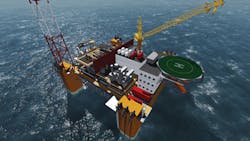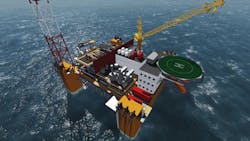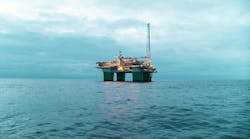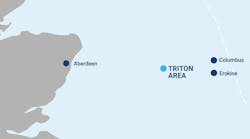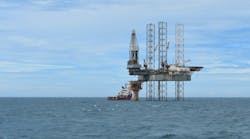Sarah Parker Musarra
Editor
In October, Aker Solutions debuted the Lean Semi, its latest platform design. In it, the company has worked to lower the weight and the cost of a conventional semisubmersible platform to make the production of certain marginal fields economically feasible.
Capable of working in water depths of 100-400 m (328-1,312 ft), the Lean Semi is designed to commercialize fields with up to 300 MMboe, ideally when located next to larger fields with excess processing capacity. The initial design is intended for Norwegian waters; however, John Nustad, business development director, Aker Solutions’ Floating & Marine Facilities group, said that the company is in the process now of tweaking the concept for a model that can be dispatched to the Gulf of Mexico. Then, it is foreseen that minimal changes, if any, will be needed for the platform to work anywhere in the world.
In times of triple-digit oil prices, such resource contingents might not have been seen as economical in the sense that they were not deemed worth the time, or the return on investment, of the oil company willing to sink the money into bringing a marginal field into production. Now, however, sinking a bit can be cost-prohibitive, and companies are scouting for ways to exploit any available resource. Thus, the right type of marginal development can become much more attractive - but only if the economics work.
“Many of the big oil companies have so many smaller fields that are not economical to build in the traditional way, the more tailored way,” he toldOffshore.
Nustad said that various elements of the platform’s design - and the design process - verged from convention in an attempt to ensure that it was as lean, nimble, and efficient as possible.
Continuing, he explained that platform designs must not only satisfy governmental regulations and standards, but also reach company specifications - all of which vary, without many commonalities between them. Of course, standardization is itself a larger principle that is debated at length throughout the industry. To this end, Nustad and Aker Solutions do not see that the bespoke approach provides a viable solution when it comes to marginal fields.
“That tailoring costs a tremendous amount of money,” Nustad commented. “If you have marginal fields and you try to tailor [a specific solution], they will not be economical. With bigger fields, it is possible, but not with marginal fields, which is what we are trying to unlock.”
To keep the Lean Semi light, the topsides was designed using low-weight skids with standardized equipment placed directly on the deck, which is a single, large, flat top that functions as a building block. In some cases, Aker Solutions partnered with specialist companies in working on the standardized equipment, including Fjords Processing for the process skid.
In another measure, Nustad explained that the necessity of every single component of the platform was questioned throughout the design process.
“The standard of the group moved to, ‘Do I really need this?’ rather than ‘This would be nice to have,’” Nustad said.
A lean philosophy was applied to the hull design. The deck is integrated, a feature which the company says aids in structural integrity. Through these and other elements, Aker Solutions found it could achieve a 30% reduction in weight over a conventional topsides design. The Lean Semi clocks in at around 6,000 metric tons (6,613 tons) with a 60,000 b/d capacity. Nustad said the topsides is capable of being scaled to anywhere from 4,000 to 10,000 metric tons (4,409 to 11,023 tons). Depending on necessary specifications, the platform could be delivered in 29 months.
By virtue of its application, the Lean Semi was designed with a short field life in mind. This decision, the company says, ensures minimal redundancy effort and could boost the unit’s chances of refurbishment and redeployment. In today’s oil price regime, it is believed that a standardized design approach with a possibility of refurbishment for other fields or late life needs is a more viable economical solution than a tailored design.
These methods were not the extent of the tools the company employed in keeping the Lean Semi’s cost down: In fleshing out its new creation, the company sourced proven elements from two of its platforms that had been working successfully in two very different basins. The first was in Aker Solutions’ own backyard: Njord A in the Norwegian Sea, operating in the Njord field since 1997. A critical building block feature of the Lean Semi was one that was integral to the older harsh environment platform: the wet truss structure, which allows for waves to reach the truss. This concept lowers the platform’s center of gravity and reduces the structure’s height and hull volume, resulting in a cost savings over a conventional platform.
Another major building block component milled from a previous design is the unmanned hull concept from the Chevron-operated Blind Faith, located 160 mi (257 km) southeast of New Orleans in the deepwater Gulf of Mexico. The hull is designed without manned spaces and without connection between pump rooms in the four quadrants, Nustad said. Two caisson pumps are located in each of the hull’s columns, for ballasting and de-ballasting.
NORSOK standards are used for the Lean Semi’s safety design, which Aker Solution says includes firewater, lifeboats, etc. The unmanned hull is sized according to Norwegian and International standards.
The internally-financed Lean Semi is ready for its first client.
